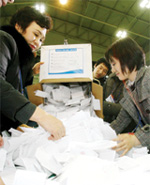The Constitutional Court
The Constitutional Court was established in September 1988 as a key part of the constitutional system. The Constitution of the Sixth Republic, based on the Korean people's deep enthusiasm for democracy, adopted a new judicial review system ― the Constitutional Court ― to safeguard the Constitution and to protect the people's basic rights by establishing special procedures for the adjudication of constitutional issues.
The Court is empowered to interpret the Constitution and to review the constitutionality of all statutes, to make judicial decisions on impeachment or on dissolution of a political party, and to pass judgment in competence disputes and constitutional complaints.
The Court is composed of nine Justices. The term of office for Justices is six years and is renewable. The courthouse is a five-story domed building in Seoul which has won the Korean Architectural Award.
National Election Commission

All citizens aged 19 or older are eligible to vote.
In accordance with the provision of Article 114 of the Constitution, the National Election Commission was established as an independent constitutional agency compatible with the National Assembly, the government, courts and the Constitutional Court of Korea for the purpose of fair management of elections and national referenda. It also deals with administrative affairs concerning political parties and political funds.
The term and status of each Election Commissioner is strictly guaranteed as prescribed in the Constitution. They ard guaranteed fair execution of duties without any external interference.
National Human Rights Commission
The Commission was established in 2001 as a national advocacy institution for human rights protection. It is committed to the fulfillment of human rights in a broader sense, including dignity, value and freedom of every human being, as signified in international human rights conventions and treaties to which Korea is a signatory.
The Commission is comprised of 11 Commissioners including the Chairperson, 3 Standing Commissioners and 7 Non-standing Commissioners. Among the 11 Commissioners, 4 shall be elected by the National Assembly, 4 shall be nominated by the President of Korea, and 3 shall be nominated by the Chief Justice of the Supreme Court and then approved by the President of Korea.